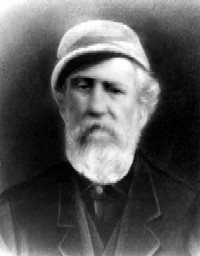Benjamin B. Dailey
Benjamin Baxter Dailey (1844-1914) was the keeper of several lifeboat stations for the United States Life-Saving Service—one of the precursor services to the United States Coast Guard.[1][2]
On December 22, 1884, when he commanded the Cape Hatteras Lifeboat Station, he led the rescue of nine men from the Ephraim Williams. For this rescue, Dailey and his crew were awarded the Gold Lifesaving Medal
The stranded men had been shipwrecked in a heavy storm for 90 hours, five miles, or seven miles, off the coast of Cape Hatteras.[1][3][4][5] According to Life magazine Dailey explained in his report to superiors that he wasn't able to draft a report on the rescue for seven days as his hands were too raw from the exertion.
The US National Park Service's has preserved Dailey's medal at its Hatteras Museum.[6]
In 2014 the Coast Guard published a list of ten individuals who were to be namesakes for Sentinel class cutters.[1] All the Sentinel class cutters are to be named after men and women who have been recognized as heroes serving in the US Coast Guard, or a precursor service. Dailey was named in the second cohort of heroes, and the USCGC Benjamin Dailey was accepted by the Coast Guard in April 2017.[7] The cutter was commissioned in Pascagoula, MS on 4 July 2017, with almost 100 members of the Dailey family in attendance.
David Stick, author of "Graveyard of the Atlantic: Shipwrecks of the North Carolina Coast", described the wills made out by Dailey and his crew, when he commanded the Creed's Hill Lifesaving Station in April 1881, prior to setting out on a particularly dangerous rescue effort.[8]
References
[edit]- ^ a b c Christopher Havern (2014-01-23). "Benjamin B. Dailey". USCG. Archived from the original on 2014-08-28. Retrieved 2014-08-28.
- ^ "Who are some of the heroes of the Coast Guard?". USCG. 2014-08-26. Archived from the original on 2014-03-15. Retrieved 2014-08-27.
- ^ "Rowboats to choppers, tales of rescue at sea". Life magazine. 1967-07-15. p. 50. Retrieved 2014-08-27.
- ^
"Two Tales of Bravery from the U.S. Life-Saving Service". Carolina Outer Banks. Archived from the original on 2014-08-28. Retrieved 2014-08-27.
The other crews knew it was hopeless, sure the surfboat could not make it over the treacherous outer sandbar with the sea conditions that existed that day. But luck and skill prevailed, and the small boat somehow made it across.
- ^ "Hatteras Island Lifesaving Stations". North Caroline Beaches. Archived from the original on 2014-09-03.
- ^
"The U.S. Lifesaving Service". National Park Service. Archived from the original on 2014-07-15. Retrieved 2014-08-27.
Cape Hatteras National Seashore preserves the history of the U.S. Lifesaving Service on the Outer Banks. Walk the same beaches that Rasmus Midgett once patrolled or stop and see what Keeper Dailey's medal looks like at the Museum of the Sea near the Cape Hatteras Lighthouse.
- ^
"FRC Plan B: The Sentinel Class". Defense Industry Daily. 2014-05-02. Archived from the original on 2014-07-07. Retrieved 2014-04-03.
All of these boats will be named after enlisted Coast Guard heroes, who distinguished themselves in USCG or military service. The first 25 have been named, but only 8 have been commissioned...
- ^
David Stick (1989). "Graveyard of the Atlantic: Shipwrecks of the North Carolina Coast". University of North Carolina Press. ISBN 9780807842614. Retrieved 2014-08-28.
The Ephraim Williams, a 491-ton vessel loaded with lumber and bound from Savannah, Georgia, to her home port of Providence, Rhode Island, with a crew of nine, ran into a storm off Frying Pan Shoals December 18 and soon became waterlogged and unmanageable.

